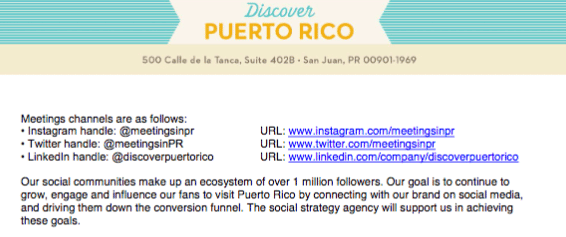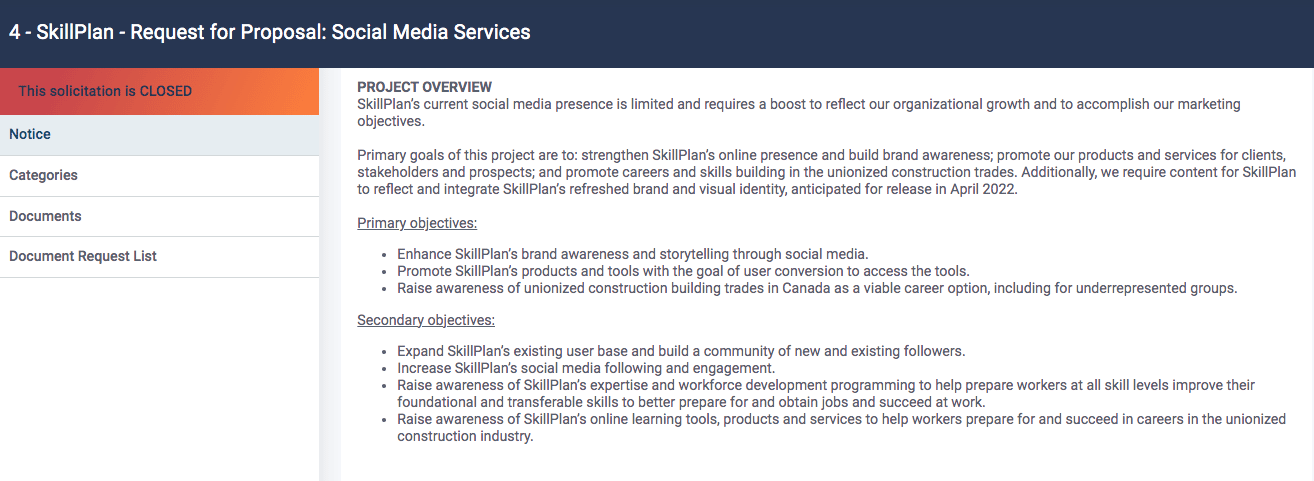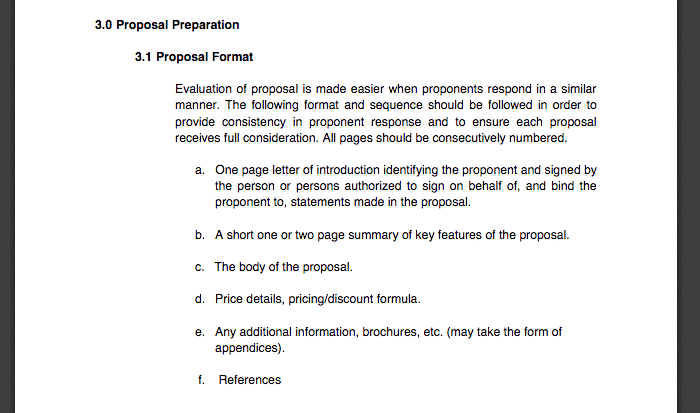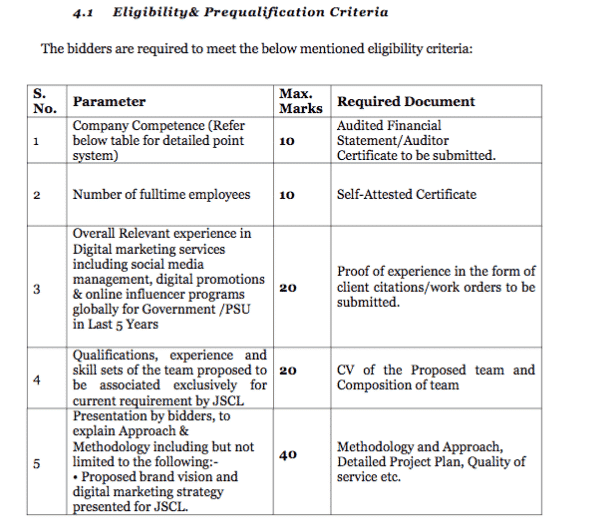Social Media RFP: Free Templates and Examples
A social media request for proposal (RFP) is the starting place for many successful social media strategies, campaigns, and collaborations.
Actually, a social media RFP template is the starting place. Creating a great RFP for social media marketing services isn’t easy, after all.
Write something too vague, and you’ll be sifting through unhelpful applications.
Leave too many questions unanswered? You’ll spend all your time writing lengthy responses to emails from interested vendors.
Whether you’re an agency or vendor, what you get out of a social media RFP depends on what you put into it. So why not use a tried-tested-and-true social media RFP template to set your project or brand off on the right foot?
Bonus: Get the free social media RFP template to create your own in minutes and find the right agency to help you achieve your goals.
What is a social media RFP?
Here’s some important marketing vocab for you: RFP stands for “request for proposal.”
A social media RFP is an open call for pitches, whether for a one-off project or a longer-term collaborative relationship. It can be put out to social media marketing agencies or individual practitioners.
Your RFP for social media marketing services might do the following:
- Outline a specific project or need your business wants to address
- Invite agencies, management platforms, or other vendors to pitch creative ideas or solutions for your brand as a whole
The RFP process allows companies to vet ideas and providers before committing to a long-term agreement. Think of it as an opportunity to scope out your options before locking one down.
A good RFP for social media management services should provide background, describe the project and its objectives, and spell out bidder requirements.
But it’s a delicate balance between providing info and oversharing. A good RFP for social media will provide the necessary amount of detail while leaving room for creativity. It’s worth taking your time and doing it right — the better your RFP, the better the vendor proposals will be.
(FYI: RFPs can be used for other business needs as well. You might create an RFP for help with a print marketing campaign or for manufacturing services. A social media RFP is specifically seeking proposals in the field of social media marketing.)
What to include in a social media RFP
Wondering what to include in your social media RFP?
While every RFP is different, most strong social media RFPs feature a few common elements. (Just read a few social media RFP examples, and you’ll see these same details coming up again and again and again.)
Your social media content itself should be creative. But for social media RFPs, it really is best to stick with a proven structure.
Whether you want to work with a social media agency, digital marketing agency, or individual contractor, we recommend including these ten sections (in this order!) for your next social media RFP.
1. Introduction
2. Company profile
3. Social media ecosystem
4. Project purpose and description
5. Challenges
6. Key questions
7. Bidder qualifications
8. Proposal guidelines
9. Project timelines
10. Proposal evaluation
We’ve broken down each section so you can get a better sense of what to include in your RFP for social media services.
1. Introduction
This is your first impression: a chance to give a big-picture overview of what you’re looking for. It’s like your objective on a resume.
Provide a top-level summary of your social media RFP. This short section should include key details such as your company name, what you’re looking for, and your submission due date.
Here’s an example:
Fake Company, Inc., the global leader in fake companies, is looking for a fake social media awareness campaign. We are accepting proposals in response to this fake request for proposal until [date].
2. Company profile
Time to peel back some layers and let the reader know what your brand is all about.
Share some background on your company. Go beyond the basics and provide information that may be relevant to an RFP for social media marketing services.
This may include your:
- Mission statement
- Core values
- Target customers
- Key stakeholders
- Competitive landscape
But you don’t have to give away any proprietary info or trade secrets. If including any of the above in your social media RFP would put your company at risk, just note that additional information is available upon request and/or NDA signature.
3. Social media ecosystem
To get great social media proposals, you’ve got to give your vendors a peek behind the curtain. Knowledge is power!
Give vendors an overview of how your company uses social media. Let them know which social channels you’re most active on or which networks you’ve chosen to avoid. Some other things you might mention in this section may include:
- A summary of active accounts
- Essential aspects of your social marketing strategy
- Overviews or links to past or ongoing campaigns
- Relevant social analytics (e.g., audience demographics, engagement, a social media audit, etc.)
- Highlights from your social accounts (e.g., content that performed well)
Discover Puerto Rico outlined its wide range of social media accounts in its social media RFP, clarifying the distinction between their leisure audience and their business audience.
SOURCE: Discover Puerto Rico
A key reason to provide this intel in your social media RFP is to avoid repetition. Without this information, you may end up with social media proposals that are too similar to past concepts.
The better a vendor understands your social media landscape, the more likely that they’ll deliver a successful concept.
4. Project purpose and description
Explain the purpose of your social media RFP. What are you looking for? What social media goals are you hoping to achieve? Be as specific as possible.
Some examples may include:
- Promote awareness of a new store opening in [location]
- Gain new followers on a recently launched social media channel
- Increase consideration for an existing product or service
- Generate more leads via specific social media channels
- Establish your company as a thought leader
- Share company values or initiatives with a target audience
- Run a seasonal promotion or social contest
Remember, social media campaigns can and should include multiple objectives. Each goal provides a box for a vendor’s proposal to tick off.
This RFP from SkillPlan outlines the company’s primary objectives and secondary objectives clearly and concisely.
SOURCE: Merx
Consider using primary and secondary goal categories so that it’s clear what matters most.
5. Challenges
The struggle is real… real important to share with your potential new social media collaborator, that is.
Most companies are well aware of the unique challenges they face on and off social media. An uninitiated third party won’t have that same understanding.
Identify roadblocks upfront in your social media RFP so you can work together to solve or work around them.
Challenges may include:
- Customer sensitivities (e.g., anything that would help a vendor avoid pressing known pain points)
- Legalese (e.g., cumbersome disclaimers and disclosures that often get in the way of creative concepts)
- Regulatory compliance (are there age or other restrictions associated with marketing your product?)
- Differentiation (is it difficult for your product or service to stand out from competitors?)
- Social media security (have you faced issues with scammers or hackers in the past?)
Resource and budget challenges may be relevant here, too. Does your company have enough staff to support necessary customer service and community management? Be honest. The best proposals could present invaluable solutions.
6. Key questions
It’s tough for a vendor to provide a great answer if they don’t know what you’re asking for.
That’s why it’s super common to find questions in social media RFPs used for marketing purposes. They often follow or are included as a subsection in Challenges. In some cases, they simply ask: How will your proposal address these challenges?
Including questions is a way to make sure that proposals provide the solutions or answers head-on rather than dodge or skirt around them. If your company faces significant challenges, these answers will make it easier to evaluate the proposals you receive.
7. Bidder qualifications
Sure, there’s a chance a young hotshot with a heart of gold is going to just crush your project. But chances are you’re looking for someone with experience. The bidder qualifications section of a social media RFP allows you to ask for what you want.
Here, you can request details on why a company may be uniquely qualified to take your project on.
Experience, past projects, team size, and other credentials are important factors when evaluating vendors who answer your RFP for social media marketing services.
Include qualifications that will make for a successful project, help you evaluate social media proposals, and are important to your business. For example, while it may not be pertinent to a social media RFP, your company may prefer B Corps.
Some things to ask for:
- Details on the size of the vendor’s team
- Proof of social media training and certification (Hootsuite’s social marketing education and certificate program, for example)
- Examples of work with past or existing clients
- Client testimonials
- Results from previous campaigns
- A list of employees—and their titles—who will work on the project
- Project management approach and strategy
- Resources that will be dedicated to the project
- Anything else about the vendor and their work that is important to you and the execution of the project
Sure, you can disregard the bidder qualifications section. But if you do, you might end up with a bunch of applications that lack the information relevant for you to make a decision. So include anything and everything you want to see from prospective vendors.
8. Proposal guidelines
This is where you get into the nitty gritty: how exactly do you want this social media RFP packaged and delivered?
This section should cover proposal submission basics: when, what, where, and how much. Indicate the deadline for submission, how proposals should be formatted, and the level of detail you require for budget breakdowns.
The Government of Nova Scotia gives vendors a clear outline for their proposals.
SOURCE: Nova Scotia
If your company has brand guidelines, social media guidelines, a social media style guide, or any other relevant resources, include links or information on where vendors can find them.
Make sure to add a point of contact as well. Our social media RFP template puts contact information in the header. But it doesn’t matter whether you put it first or last. Just make sure it’s available for agencies to direct questions or clarifications.
9. Project timelines
Every social media RFP should indicate proposal and project deadlines. You won’t find a social media RFP example without one.
In this section, provide a structured proposal schedule that vendors can follow. If your project is tied to a specific date or event, include those key delivery dates too, but if you’ve got some flexibility, it’s OK to be broad here.
A social media RFP timeline may include:
- Deadline to RSVP participation
- Meeting period with vendors for preliminary discussions
- Deadline for agencies to submit questions
- Proposal submission deadline
- Finalist selection
- Finalist presentations
- Selection of winning proposal
- Contract negotiation period
- When notifications will be sent to bidders who were not selected
- Include a hard deadline or target project date. If key milestone and deliverable deadlines are already in place, that should be indicated here as well.
10. Proposal evaluation
Just like teachers provide students with rubrics, you should offer vendors a clear set of judgment guidelines to work towards. How can they wow you if they don’t know what wows you?
Both you and prospective vendors should know ahead of time how their proposals will be evaluated. List the criteria you will measure and how each category will be weighted or scored.
The National Institute of Urban Affairs provides a detailed chart outlining how each application will be judged. Intimidating? Yes. Clear? Also yes.
SOURCE: National Institute of Urban Affairs
Be as transparent about your agency selection process as possible. If a rubric template or scorecard is available, include it here. If evaluators will provide comments, let bidders know whether they should or should not expect to receive them.
Finally, indicate the stated budget’s role in your decision-making process. Will it be revealed to evaluators after they’ve scored the proposal? How will you determine cost vs. value?
Social media RFP template
If you skimmed over all that content, we don’t blame you—it’s a lot to take in!
That’s precisely why we built this free social media RFP example: a template to make things easy for you.
Bonus: Get the free social media RFP template to create your own in minutes and find the right agency to help you achieve your goals.
Use this social media RFP template as a starting point, and tailor it to your needs. You’ll be able to use this to create your own in minutes and find the right vendor to help you achieve your goals.
Save time managing your social media presence with Hootsuite. Publish and schedule posts, find relevant conversions, engage your audience, measure results, and more — all from one simple dashboard. Try it free today.
Do it better with Hootsuite, the all-in-one social media tool. Stay on top of things, grow, and beat the competition.
Free 30-Day TrialThe post Social Media RFP: Free Templates and Examples appeared first on Social Media Marketing & Management Dashboard.
Categories
- 60% of the time… (1)
- A/B Testing (2)
- Ad placements (3)
- adops (4)
- adops vs sales (5)
- AdParlor 101 (43)
- adx (1)
- AI (4)
- algorithm (1)
- Analysis (14)
- Apple (1)
- Audience (1)
- Augmented Reality (1)
- authenticity (1)
- Automation (1)
- Back to School (1)
- best practices (2)
- brand voice (1)
- branding (1)
- Build a Blog Community (12)
- Calculator (1)
- Case Studies (2)
- Case Study (3)
- celebrate women (1)
- certification (1)
- Collections (1)
- Community (1)
- Conference News (2)
- conferences (1)
- confluence (1)
- content (1)
- content creation (24)
- Content creators (2)
- content curation (1)
- content marketing (3)
- contests (1)
- Conversion Lift Test (1)
- Conversion testing (1)
- cost control (2)
- Creative (6)
- crisis (1)
- Curation (1)
- Custom Audience Targeting (4)
- Customer service (7)
- Digital Advertising (2)
- Digital Marketing (6)
- DPA (1)
- Dynamic Ad Creative (1)
- dynamic product ads (1)
- E-Commerce (1)
- eCommerce (2)
- Ecosystem (1)
- email marketing (3)
- Employee advocacy (2)
- employee advocacy program (1)
- employee advocates (1)
- engineers (1)
- event marketing (1)
- event marketing strategy (1)
- events (3)
- Experiments (32)
- F8 (2)
- Facebook (64)
- Facebook Ad Split Testing (1)
- facebook ads (18)
- Facebook Ads How To (1)
- Facebook Advertising (30)
- Facebook Audience Network (1)
- Facebook Creative Platform Partners (1)
- facebook marketing (1)
- Facebook Marketing Partners (2)
- Facebook Optimizations (1)
- Facebook Posts (1)
- facebook stories (1)
- Facebook Updates (2)
- Facebook Video Ads (1)
- Facebook Watch (1)
- fbf (11)
- first impression takeover (5)
- fito (5)
- Fluent (1)
- Free tool (2)
- Get Started With Wix Blog (1)
- Google (9)
- Google Ad Products (5)
- Google Analytics (1)
- Government (1)
- Guest Post (1)
- Guide (2)
- Guides (32)
- Halloween (1)
- Healthcare (2)
- holiday marketing (1)
- Holiday Season Advertising (7)
- Holiday Shopping Season (4)
- Holiday Video Ads (1)
- holidays (4)
- Hootsuite How-To (3)
- Hootsuite HQ (1)
- Hootsuite Life (1)
- how to (6)
- How to get Instagram followers (1)
- How to get more Instagram followers (1)
- i don't understand a single thing he is or has been saying (1)
- if you need any proof that we're all just making it up (2)
- Incrementality (1)
- influencer marketing (2)
- Infographic (1)
- Instagram (39)
- Instagram Ads (11)
- Instagram advertising (8)
- Instagram best practices (1)
- Instagram followers (1)
- Instagram Partner (1)
- Instagram Stories (2)
- Instagram tips (1)
- Instagram Video Ads (2)
- invite (1)
- Landing Page (1)
- Legal (1)
- link shorteners (1)
- LinkedIn (22)
- LinkedIn Ads (2)
- LinkedIn Advertising (2)
- LinkedIn Stats (1)
- LinkedIn Targeting (5)
- Linkedin Usage (1)
- List (1)
- listening (2)
- Lists (3)
- Livestreaming (1)
- look no further than the new yorker store (2)
- lunch (1)
- Mac (1)
- macOS (1)
- Marketing to Millennials (2)
- mental health (1)
- metaverse (2)
- mobile (2)
- Mobile App Marketing (3)
- Monetizing Pinterest (2)
- Monetizing Social Media (2)
- Monthly Updates (10)
- Mothers Day (1)
- movies for social media managers (1)
- new releases (11)
- News (80)
- News & Events (12)
- no one knows what they're doing (2)
- Non-profit (2)
- OnlineShopping (2)
- or ari paparo (1)
- owly shortener (1)
- Paid Media (2)
- People-Based Marketing (3)
- performance marketing (5)
- Pinterest (34)
- Pinterest Ads (11)
- Pinterest Advertising (8)
- Pinterest how to (1)
- Pinterest Tag helper (5)
- Pinterest Targeting (6)
- platform health (1)
- Platform Updates (8)
- Press Release (2)
- product catalog (1)
- Productivity (10)
- Programmatic (3)
- quick work (1)
- Real estate (4)
- Reddit (3)
- reels (1)
- Reporting (1)
- Resources (27)
- ROI (1)
- rules (1)
- Seamless shopping (1)
- share of voice (1)
- Shoppable ads (4)
- short-form video (2)
- shorts (2)
- Skills (25)
- SMB (1)
- SnapChat (28)
- SnapChat Ads (8)
- SnapChat Advertising (5)
- Social (149)
- social ads (1)
- Social Advertising (14)
- Social commerce (3)
- social customer service (1)
- Social Fresh Tips (2)
- Social listening (3)
- Social Media (5)
- Social Media Advertising (2)
- Social media analytics (11)
- social media automation (1)
- Social media benchmarks (1)
- Social media career (2)
- social media content calendar (1)
- Social media content creation (3)
- Social media engagement (8)
- social media for events (1)
- social media management (2)
- Social Media Marketing (49)
- social media monitoring (1)
- Social Media News (4)
- Social media scheduling (5)
- social media statistics (1)
- Social media stats (4)
- Social Media Strategy (36)
- social media tools (22)
- social media tracking in google analytics (1)
- Social media trends (5)
- social media tutorial (2)
- Social Toolkit Podcast (1)
- Social Video (14)
- stories (1)
- Strategy (858)
- Teamwork (2)
- Template (5)
- terms (1)
- Testing (2)
- there are times ive found myself talking to ari and even though none of the words he is using are new to me (1)
- they've done studies (1)
- this is also true of anytime i have to talk to developers (1)
- tiktok (14)
- tool (1)
- tools (1)
- Topics & Trends (3)
- Trend (12)
- Twitter (15)
- Twitter Ads (5)
- Twitter Advertising (4)
- Uncategorised (9)
- Uncategorized (13)
- url shortener (1)
- url shorteners (1)
- vendor (2)
- video (14)
- Video Ads (7)
- Video Advertising (8)
- virtual conference (1)
- we're all just throwing mountains of shit at the wall and hoping the parts that stick don't smell too bad (2)
- web3 (2)
- where you can buy a baby onesie of a dog asking god for his testicles on it (2)
- yes i understand VAST and VPAID (1)
- yes that's the extent of the things i understand (1)
- YouTube (13)
- YouTube Ads (4)
- YouTube Advertising (9)
- YouTube Video Advertising (5)




